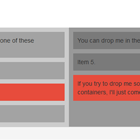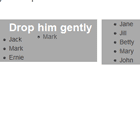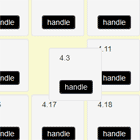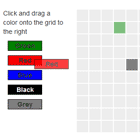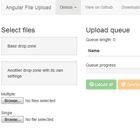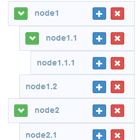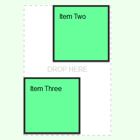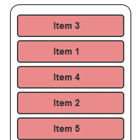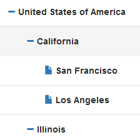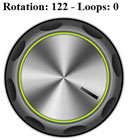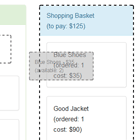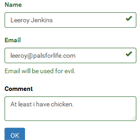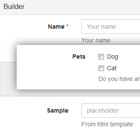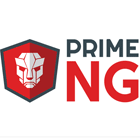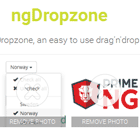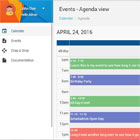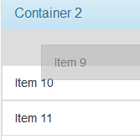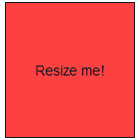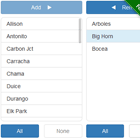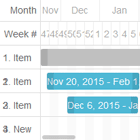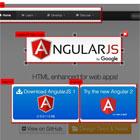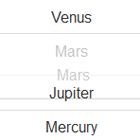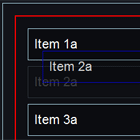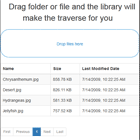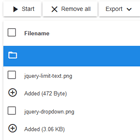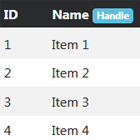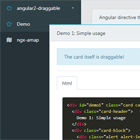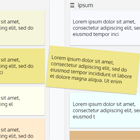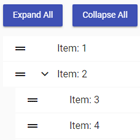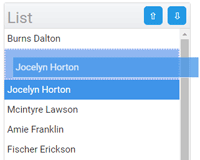Dragular
Angular drag&drop based on dragula
Browser support includes every sane browser and IE7+. (Granted you polyfill the functional Array methods in ES5)
⚠️ IMPORTANT NOTICE!!! ⚠️
Maitanance of this library is from now in energy saving mode. I will continue to fix bugs which does not require too heavy rewrites like #133 for example. Because I am working on new drag&drop library called dragon which will be more customisable/maintainable/usable. That is the reason I decided to redirect more of my energy from my other open projects. Thank you for your understanding.
=== Demo ===
Inspiration
I was working on angular project using several drag&drop libraries in it, one for UI elements, one for lists, etc.. I wanted to use one full-featured drag&drop library for whole project. As I could not find any suitable, I decided to create one. I have choosen great library dragula by Nicolas Bevacqua as my starting point, make it more angular and started to put features in it! If you wish light-weight angular version of dragula, there is official angular version of dragula.
Actual version 4.6.0 is based on dragula 3.6.3 and tested with angular 1.6.5.
Differences of dragular (against dragula)
- replaced dragula crossvent with angulars event binding
- replaced dragula contra.emitter with $scope.$emit if scope provided in options (options.scope)
- provided as service or directive dragular where options can be passed via atribute dragular
- automatic direction if not provided in options, instead of default vertical
- accepting arraylike objects as containers array (jQuery, jQlite collections etc..)
- accepting custom classes via option.classes
- accepting custom event names via option.eventNames
- namespaced containers groups available via option.nameSpace (containers in same nameSpace cooperate)
- boundingBox (dragging element can me moved only in specific area)
- lockX/Y (dragging element can me moved only in specific direction)
- DOM can be synced with scope model
- support css selectors to define containers
- added syntax highlighter to example codes
- etc..
Features
- provided as service and also as directive
- Easy to set up
- No bloated dependencies
- A shadow where the item would be dropped offers visual feedback
- Touch events!
- DOM can be synced with model
- area or axes of movement can be restricted
Install
download dragular.js and dragular.css from dist folder
OR clone git
git clone http://github.com/luckylooke/dragular.git OR use npm
[sudo] npm install dragular OR use bower
bower install dragular AND include files into your project
<link href='styles/dragular.css' rel='stylesheet' type='text/css' /> <script src='scripts/dragular.js'></script>AND put dragularModule into dependency array
var app = angular.module('myApp', ['dragularModule', 'otherDependencies']);DONE :)
Usage
Dragular provides the easiest possible API to make drag and drop a breeze in your applications. You can use it as service or as directive. Both arguments are optional. But you need to tell dragular what element(s) to use as container(s)(container is closest wrapping element of draggables and also it serves as droppable area). In service you can provide them in forst argument or in second via options.containers. Options.containers property is higher priority!
As service dragularService(containers?, options?)
By default, dragular will allow the user to drag an element in any of the containers and drop it in any other container in the list. If the element is dropped anywhere that's not one of the containers, the event will be gracefully cancelled according to the revertOnSpill and removeOnSpill options.
Note that dragging is only triggered on left clicks, and only if no meta keys are pressed. Clicks on buttons and anchor tags are ignored, too.
The example below allows the user to drag elements from left into right, and from right into left.
dragularService('#left, #right');Containers supported types:
| Type | Description |
|---|---|
element | single element of container |
string | css selector (document.querySelectorAll, beware browser support), one or multiple containers |
array | array of DOM elements |
array-like | object containing elements on numerical properties (jQuery wrapper, jQlite, etc..), must have length property |
You can also provide an options object into service as second parameter.
dragularService(containers, options);for example
dragularService(containers, { moves: function (el, container, handle) { return true; // elements are always draggable by default }, accepts: function (el, target, source, sibling) { // applied with target container options return true; // can target accept dragged item? (target context used) }, canBeAccepted: function (el, target, source, sibling) { // applied with source container options return true; // can be dragged item accepted by target? (source context used) }, direction: 'vertical', // Y axis is considered when determining where an element would be dropped revertOnSpill: false, // item returns to original place removeOnSpill: false // item will be removed if not placed into valid target });As directive
For now just as attribute (restrict: A)!
<div dragular="dragularOptions"></div>The dragularOptions can be any name of property where options object is located or angular expression resulting with options object.
$scope.dragularOptions = { classes: { mirror: 'custom-green-mirror' }, nameSpace: 'common', direction: 'horizontal' };OR providing options as JSON
<div dragular='{"classes":{"mirror":"custom-green-mirror"},"nameSpace":"common"}'></div>dragular-model atribute
Model can be optionaly provided via dragular-model atribute, but only in case you are using dragular directive next to it. If presented it has higher priority than options.containersModel property and it extends options provided in dragula attribute into new options object!.
<div dragular-model="items"></div>dragular-name-space atribute
For better readability of views.
<div dragular-name-space="oranges"></div>dragular-on-init atribute
Same as options.onInit see bellow.
Options
The options are detailed below. All boolean options can be also function returning boolean except lockX and lockY!
options.containers
Container element, NodeList, array of elements, jQuery object returned by selector or any array-like object where containers elements are placed on properties named 0,1,2,.. etc.
options.containersModel
If you wish to have model synced with containers state, you need to provide it within this property. For single container you can provide an array with items in it. Items can by any type. For multiple containers you need to provide array of arrays (2D-array), where order of arrays representing containers (models) must be same as order of containers elements provided in containers parameter of service.
You can also provide callback function via options.containersModel which is called everytime drag starts. It must return array or 2D-array as mentioned in above paragraph.
String can be also provided to options.containersModel which is used against options.scope if provided, if not there is also opportunity to provide another object via options.containersModelCtx to be used as context and provided string will be evaluated against this object. In case that both options.containersModelCtx and options.scope are provided, options.containersModelCtx has higher priority, so it will be evaluated against it. Target property must be array or 2D-array as mentioned in first paragraph.
Please note that if you are using filters on your items you must provide filtered array no source one!
<input ng-model="query"> <div id="container"> <div ng-repeat="item in getFilteredModel(filteredItems, sourceItems, query)"> {{item}} </div> </div>$scope.filteredItems = []; dragularService('#container', { containersModel: sourceItems, containersFilteredModel: $scope.filteredItems }); $scope.getFilteredModel = function (filteredModel, items, filterQuery) { filteredModel.length = 0; /* * Following one-liner is same like: * var filteredModelTemp = $filter('filter')(items, filterQuery); * angular.forEach(filteredModelTemp, function(item){ * filteredModel.push(item); * }); * Or like: * var filteredModelTemp = $filter('filter')(items, filterQuery); * for(var i; i < filteredModelTemp.length; i++){ * filteredModel.push(filteredModelTemp[i]); * } * * You cannot just assign filtered array to filteredModel like this: * filteredModel = $filter('filter')(items, filterQuery); * Because you would replace the array object you provide to dragular with new one. * So dragular will continue to use the one it was provided on init. * Hopefully I make it clear. :) */ [].push.apply(filteredModel, $filter('filter')(items, filterQuery)); return filteredModel; };options.containersFilteredModel
See 'options.containersModel' above for usecase.
options.isContainer( element )
Element can be forced to be container by custom logic function. Tested element is passed as argument. It is an element under dragged item called recursivelly so it can be also parent of element under the item or parent of a parent, etc..
options.isContainerModel( element )
If isContainer function is provided, you can provide also respective model. Tested element is passed as argument.
options.isContainerAccepts( shared.item, target, shared.source, reference, shared.sourceModel, shared.initialIndex )
If isContainer function is provided, you can provide also respective acceptation function. Parameters are same as for options.accepts.
options.moves
You can define a moves callback which will be invoked with (el, container, handle) whenever an element is clicked. If this method returns false, a drag event won't begin, and the event won't be prevented either. The handle element will be the original click target, which comes in handy to test if that element is an expected "drag handle".
options.accepts
You can set accepts to a method with the following signature: (el, target, source, sibling, sourceModel, initialIndex). It'll be called to make sure that an element el, that came from container source, can be dropped on container target before a sibling element. The sibling can be null, which would mean that the element would be placed as the last element in the container. Note that if options.copy is set to true, el will be set to the copy, instead of the originally dragged element. Applied with options provided with initialisation of target container.
Also note that the position where a drag starts is always going to be a valid place where to drop the element, even if accepts returned false for all cases.
options.canBeAccepted
Same as options.accepts but applied with options provided with initialisation of source container.
options.copy
options.copy( el, source )
If copy is set to true (or a method that returns true), items will be copied rather than moved. This implies the following differences:
| Event | Move | Copy |
|---|---|---|
dragulardrag | Element will be concealed from source | Nothing happens |
dragulardrop | Element will be moved into target | Element will be cloned into target |
dragularremove | Element will be removed from DOM | Nothing happens |
dragularcancel | Element will stay in source | Nothing happens |
If a function is passed, it'll be called whenever an element starts being dragged in order to decide whether it should follow copy behavior or not. Consider the following example.
copy: function (el, source) { return el.className === 'you-may-copy-us'; }If you wish to event handlers binded to element to be copied too, you need to set copy option to 'events' value. It will trigger 'deepWithDataAndEvents' option in clone method of jQlite described in jQuery docs
copy: 'events'options.copySortSource
If copy is set to true (or a method that returns true) and copySortSource is true as well, users will be able to sort elements in copy-source containers.
copy: true, copySortSource: trueoptions.revertOnSpill
By default, spilling an element outside of any containers will move the element back to the drop position previewed by the feedback shadow. Setting revertOnSpill to true will ensure elements dropped outside of any approved containers are moved back to the source element where the drag event began, rather than stay at the drop position previewed by the feedback shadow.
options.removeOnSpill
By default, spilling an element outside of any containers will move the element back to the drop position previewed by the feedback shadow. Setting removeOnSpill to true will ensure elements dropped outside of any approved containers are removed from the DOM. Note that remove events won't fire if copy is set to true.
options.direction
When an element is dropped onto a container, it'll be placed near the point where the mouse was released. If the direction is 'vertical', the Y axis will be considered. Otherwise, if the direction is 'horizontal', the X axis will be considered. Default is automatic, where simple logic determines direction by comparison of dimensions of parent and its first child.
options.scope
Scope can be provided for emitting events, you can provide whichever scope you like.
options.lockX
Lock movement into x-axis.
options.lockY
Lock movement into y-axis.
options.boundingBox
Lock movement inside provided element boundaries.
options.mirrorContainer
Parent element for placing mirror helper element. (default is document.body)
options.ignoreInputTextSelection
Text selection in inputs wont be considered as drag (default is true).
options.classes
Default classes used by dragular can be modified here, providing object with custom names.
defaultClasses = { mirror: 'gu-mirror', hide: 'gu-hide', unselectable: 'gu-unselectable', transit: 'gu-transit' }, // custom example myClasses = { mirror: 'super-mirror' }options.eventNames
Default event names can be modified here, providing object with custom names.
defaultEventNames = { // drag-over DOM events dragularenter: 'dragularenter', dragularleave: 'dragularleave', dragularrelease: 'dragularrelease', // $scope events dragularcloned: 'dragularcloned', dragulardrag: 'dragulardrag', dragularcancel: 'dragularcancel', dragulardrop: 'dragulardrop', dragularremove: 'dragularremove', dragulardragend: 'dragulardragend', dragularshadow: 'dragularshadow', dragularover: 'dragularover', dragularout: 'dragularout' } // custom example myEventNames = { dragularenter: 'denter', dragularleave: 'dleave' }options.compileItemOnDrop
In case your draggable items are customized by other directives/attributes, you can use this flag to run compilation of droped item after drop. It is not supposed to be used with containers items rendered by ng-repeat. In such case you are supposed to add directives/attributes to item template and use logic in controller to enable/disable them.
options.onInit
You can provide function callback called after dragular initialisation with drake as first argument and options object as second argumant.
Events
If $scope is provided as options.scope the following events can be tracked using $scope.$on(type, listener):
| Event Name | Listener Arguments | Event Description |
|---|---|---|
dragulardrag | Event, el, container | el was lifted from container |
dragularrelease | Event, el, container, DOM-Event | user released button |
dragulardragend | Event, el | Dragging event for el ended with either cancel, remove, or drop |
dragulardrop | Event, el, target-container, source-container, con-model, el-index, target-model, drop-index | el was dropped into target-container from source-container, con-model if models are used, provides model representating the source container and el-index is original index(position) in source-container. target-model is model of target container and drop-index is index (position) of drop. |
dragularcancel | Event, el, container, con-model, el-index | el was being dragged but it got nowhere and went back into container, its last stable parent. con-model if models are used, provides model representating the source container and el-index is original index(position) in container. |
dragularremove | Event, el, container, con-model, el-index | el was being dragged but it got nowhere and it was removed from the DOM. Its last stable parent was container. con-model if models are used, provides model representating the source container and el-index is original index(position) in container. |
dragularshadow | Event, el, container, DOM-Event | el, the visual aid shadow, was moved into container. May trigger many times as the position of Event, el changes, even within the same container |
dragularcloned | Event, clone, original | DOM element original was cloned as clone. Triggers for mirror images and when copy: true |
dragularover | Event, el, target, container, DOM-Event | Dragged element el left hover target target and orginaly came from container |
dragularout | Event, el, target, container, DOM-Event | Dragged element el left hovered target target and orginaly came from container |
Event names can be modified via options.eventNames.
API
The dragularService method returns a tiny object with a concise API. We'll refer to the API returned by dragularService as drake.
drake.dragging
This property will be true whenever an element is being dragged.
drake.start(item)
Enter drag mode without a shadow. This method is most useful when providing complementary keyboard shortcuts to an existing drag and drop solution. Even though a shadow won't be created at first, the user will get one as soon as they click on item and start dragging it around. Note that if they click and drag something else, .end will be called before picking up the new item.
drake.end()
Gracefully end the drag event as if using the last position marked by the preview shadow as the drop target. The proper cancel or drop event will be fired, depending on whether the item was dropped back where it was originally lifted from (which is essentially a no-op that's treated as a cancel event).
drake.cancel(revert)
If an element managed by drake is currently being dragged, this method will gracefully cancel the drag action. You can also pass in revert at the method invocation level, effectively producing the same result as if revertOnSpill was true.
Note that a "cancellation" will result in a cancel event only in the following scenarios.
revertOnSpillistrue- Drop target (as previewed by the feedback shadow) is the source container and the item is dropped in the same position where it was originally dragged from
drake.remove()
If an element managed by drake is currently being dragged, this method will gracefully remove it from the DOM.
drake.destroy()
Removes all drag and drop events used by dragularService to manage drag and drop between the containers. If .destroy is called while an element is being dragged, the drag will be effectively cancelled.
drake.addContainers( containers )
Method to add containers dynamicaly into drake initialised earlier.
drake.removeContainers( containers )
Method to remove containers dynamicaly from drake initialised earlier.
License
MIT
